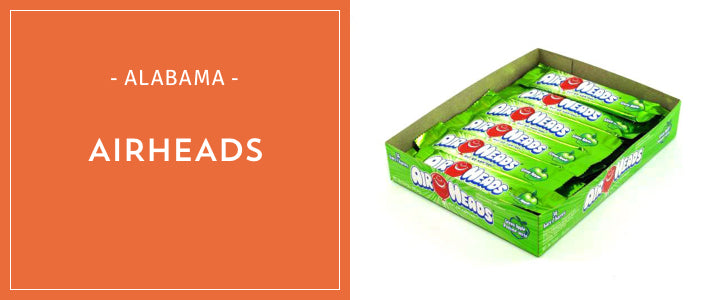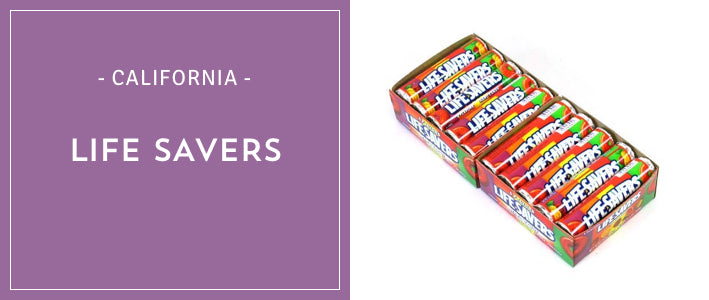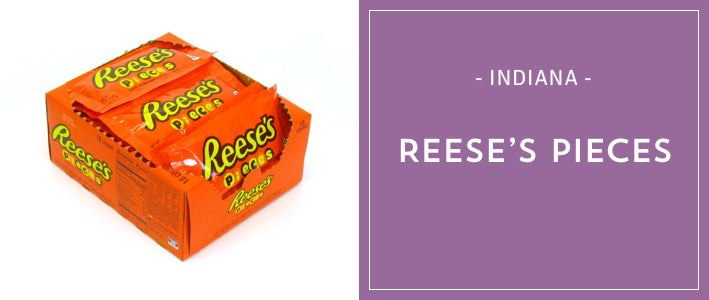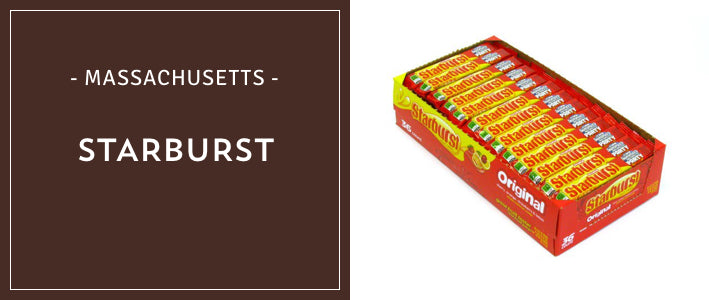It may still be summer, but the Old Time Candy team is already craving Halloween candy.
Influenster, a website that hosts product reviews, recently held a survey asking people across the United States for their favorite Halloween candy. These were the results with the most votes for each state. Did your favorite make the list?
Alabama – Airheads
AirHeads are a tangy, taffy-like, chewy candy that comes in individually wrapped strips. Have you ever noticed that everyone has their own peculiar way of eating them? From twisting the bars into really weird shapes, to rolling them into a ball, everybody’s got their own way of doing it, which just adds to the fun.
Alaska – Snickers
The Snickers bar was first introduced in 1930 and sold for 5 cents. The name came from one of the Mar’s family’s favorite horses. Snickers continues today as the top selling candy bar in the United States. We first saw the Mars Bar in the United States in 1936. It contained nougat and almonds topped with caramel and covered with milk chocolate. It was renamed the Snickers Almond bar in 2000.
Arizona – Toblerone
Theodor Tobler and Emil Baumann (Theodor Tobler’s cousin) invented a unique chocolate bar, TOBLERONE! The TOBLERONE special recipe, triangular shape, and instantly recognizable logo made it distinct. “TOBLERONE” is a play on the names “Tobler” and “Torrone”, the Italian word for honey and almond nougat.
Arkansas – Skittles
Skittles were first made commercially in 1974 by a British company. They were then introduced in North America in 1979 as an import confectionery. Finally in 1982, domestic production of Skittles began in the United States. Today they are made by Wrigley.
California – Life Savers
Life Savers were invented in Cleveland, Ohio in 1912 by Clarance A. Crane who was looking for a new candy to supplement his chocolate business that slumped in the hot weather. He developed a line of hard mints but didn’t have the space or machinery to make them. He contracted with a pill manufacturer to press the mints into shape.
Colorado – Milky Way
The Milky Way bar originated in 1923 after 3 years of research and was the first filled candy bar. It was inspired by the chocolate-malt milkshake that was popular at the time. The first advertising slogan was, “A Chocolate Malted Milk in a Candy Bar.” It was an instant success.
Connecticut – Reese’s Peanut Butter Cups
The H.B Reese Candy Company began manufacturing a product made with specially processed peanut butter and HERSHEY’S Milk Chocolate in the 1920s. Introduced as simply peanut butter cups, the popular candy item is known today as REESE’S Peanut Butter Cups.
Deleware – 3 Musketeers
The 3 Musketeers was introduced in 1932 and originally had three pieces of candy in one package, flavored vanilla, chocolate and strawberry. It became a single bar made with all chocolate in 1945. It was marketed as the candy bar that was so big it could be shared with two friends.
Florida – Nestlé Crunch Bar
The Nestlé Crunch Bar came on the market in 1938. Crisped rice is mixed with milk chocolate to produce a crunchy chocolate bar and therefore the name. The name Crunch describes precisely the sound made as one chews a bit of this candy bar.
Georgia – Pixy Stix
Pixy Stix contents were originally sold as a drink mix in the 1940s but the manufacturer learned that kids were eating the sweet and sour powder right our of the package instead of mixing it with water. In the 1950s the tasty powder was repackaged as Pixy Stix.
Hawaii – 100 Grand Bar
In the late 1950’s the hottest programs on TV were quiz shows like “The $64,000 Question,” “Twenty-One,” and “The Big Surprise.” on the “Big Surprise” the contestant chose a subject area and was asked to answer then questions ranging in value from $100 to $100,000. The program sparked the idea for a new Nestlé product, introduced in 1966, the Nestlé $100,000 Bar whose name suggests its top-price qualities. The name was later changed to “100 Grand.”
Idaho – Butterfinger
Butterfinger was originally made by the same company (Curtis Candy Company)that made Baby Ruth and quickly became the company’s number 2 selling candy bar in the early 1920s. Both candy bars were made popular by dropping them out of airplanes over major cities by the company’s president, Otto Schnering.
Illinois – Snickers
The Snickers bar was first introduced in 1930 and sold for 5 cents. The name came from one of the Mar’s family’s favorite horses. Snickers continues today as the top selling candy bar in the United States. We first saw the Mars Bar in the United States in 1936. It contained nougat and almonds topped with caramel and covered with milk chocolate. It was renamed the Snickers Almond bar in 2000.
Indiana – Reese’s Pieces
Reese’s Pieces, peanut butter candy in a crunchy shell. Can you say, “E.T. phone home?” Reese’s Pieces are an extension of the Reese’s Peanut Butter Cups product line. It was designed to capitalize on the success of the chocolate-covered peanut butter cups. The candy was introduced in 1978 and became very popular with the 1982 release of E.T. the Extra-Terrestrial, in which the Reese’s Pieces were featured.
Iowa – Twix
The Twix bar originated in the united Kingdom in 1967. With its delicious butter cookie center, topped with caramel, and coated with milk chocolate, the Twix candy bar quickly became a popular treat around the world. It was released in the United states in 1979 and in 1983 the Twix PB (peanut butter) version was introduced.
Kansas – Twizzlers
Young and Smylie Candies, the manufacturers of Twizzlers candy, is one of the oldest confectionery firms in the United states. The company was established in 1845 and adopted Y&S as its trademark in 1870. The Twizzler brand was created in 1929 but didn’t go mainstream until the mid-1960s when the company changed its name to Y&S Candies. Hershey acquired the company and Twizzlers brand in 1977.
Kentucky – Whoppers
The Overland Candy Company introduced a malted milk candy product called Giants in 1939. In 1947, Overland merged with Chicago Biscuit Company, Leaf Gum, and Leaf Machinery. Leaf Brands re-introduced malted milk balls in 1949 under the name Whoppers. Today, they are made by the Hershey Company. Whoppers were first sold unwrapped, two for one cent. After the creation of cellophane wrapping machines, smaller Whoppers were packaged in cellophane and sold five for one cent. These were called “Fivesomes.”
Louisiana – Swedish Fish
In 1958, Malaco, A Swedish confectionery manufacturer, decided to expand its business by exporting a few of their products to North America. Allsorts Licorice, Ribbons and Licorice Laces candy were the first products to be exported to North America. The Malaco exporting business grew and in the late 1960s and early 1970s, Swedish Fish and Swedish Berries were developed specifically for the North American market.
Maine – Starburst
The Starburst brand was introduced in England in 1959. They were first known as Opal Fruits, the name coming from the result of a competition. The four original flavors were strawberry, lemon, orange, and lime. In 1967 Opal Fruits were brought to the United States and the name was changed to Starburst.
Maryland – Almond Joy
Peter Paul Halajian was a Connecticut candy seller int he early 1900s. Along with some other Armenian investors, he formed the Peter Paul Candy Company in 1919. The company sold various kinds of candies, but following the sugar and coconut shortages of World War II, they dropped most brands and put all of their efforts on the Mounds candy bar. The Almond Joy bar was introduced in 1946.
Massachusetts – Starburst
The Starburst brand was introduced in England in 1959. They were first known as Opal Fruits, the name coming from the result of a competition. The four original flavors were strawberry, lemon, orange, and lime. In 1967 Opal Fruits were brought to the United States and the name was changed to Starburst.
Michigan – M&M’s
M&Ms Plain and Peanut have new colors but the same candy taste you remember. “Melts in your mouth, not in your hand.” M&Ms were first introduced in 1941 to American soldiers serving in World War II. They were hand-packed in a paper tube to prevent melting in hot weather.
Minnesota – 100 Grand Bar
In the late 1950’s the hottest programs on TV were quiz shows like “The $64,000 Question,” “Twenty-One,” and “The Big Surprise.” on the “Big Surprise” the contestant chose a subject area and was asked to answer then questions ranging in value from $100 to $100,000. The program sparked the idea for a new Nestlé product, introduced in 1966, the Nestlé $100,000 Bar whose name suggests its top-price qualities. The name was later changed to “100 Grand.”
Mississippi – Hershey’s Kisses
Of course, the first addition to the HERSHEY’S product line of milk chocolate confections was HERSHEY’S KISSES Chocolates way back in 1907. Originally, each one was hand-wrapped in a square of silver foil, but in 1921 machine wrapping was introduced, along with the addition of the unique “plume” which marked it as a genuine HERSHEY’S KISSES Chocolate.
Missouri – Hershey’s Kisses
Of course, the first addition to the HERSHEY’S product line of milk chocolate confections was HERSHEY’S KISSES Chocolates way back in 1907. Originally, each one was hand-wrapped in a square of silver foil, but in 1921 machine wrapping was introduced, along with the addition of the unique “plume” which marked it as a genuine HERSHEY’S KISSES Chocolate.
Montana – Kit Kat Bar
Originally Kit Kat was named Chocolate Crisp by the inventor, Rowntree’s. The brand is now owned by Nestlé but the Hershey Company has a license to product Kit Kat bars in the United States. This arrangement dates to 1969, when Hershey negotiated an agreement for Kit Kat and the Rolo with Rowntree’s in the United States.
Nebraska – Skittles
Skittles were first made commercially in 1974 by a British company. They were then introduced in North America in 1979 as an import confectionery. Finally, in 1982, domestic production of Skittles began in the United States. Today they are made by Wrigley.
Nevada – Jolly Ranchers
The Jolly Rancher Candy Company was founded in Golden, Colorado, by Bill and Dorothy Harmsen in 1949. They called the company Jolly Rancher to suggest a hospitable, western company. The company originally made ice cream, chocolate, and hard candy. As hard candy sales grew, however, they began to concentrate on developing their “Famous for Flavor” line of hard candies. Today Jolly Rangers are made by the Hershey Company.
New Hampshire – Tootsie Rolls
Leo Hirshfield was looking around for a name for the new confection he was making from a recipe he’d brought over from Europe in 1896. He chose the name of his 6 year old daughter, Clara, whose nickname was Tootsie. Tootsie Rolls were the first penny candy to be individually wrapped in paper. They were one of the top choices of children who only had a few pennies spend on satisfying a sweet tooth.
New Jersey – Sour Patch Kids
Sour Patch Kids were originally sold with the name Mars Men in the 1970s. incredibly, these little candies actually inspired a few UFO sightings. By the mid-1980s the name was changed to the current one. It is speculated that the name change was an attempt to capture some of the excitement for Cabbage Patch Kids dolls which were popular at the time.
New Mexico – 3 Musketeers
The 3 Musketeers was introduced in 1932 and originally had three pieces of candy in one package, flavored vanilla, chocolate, and strawberry. It became a single bar made with all chocolate in 1945. It was marketed as the candy bar that was so big it could be shared with two friends.
New York – SweeTARTS
SweeTarts are sweet and sour candies created by the Sunline Candy Company. The tablets used the same basic recipes the already popular Pixy Stix and Lik-M-Aid candies. It was a response to parents’ requests for a less-messy candy. SweeTarts were introduced in 1963 with the same flavors as the popular Pixy Stix: cherry, lime, lemon, and orange. Today, SweeTarts are manufactured by Wonka.
North Carolina – Butterfinger
Butterfinger was originally made by the same company (Curtis Candy Company)that made Baby Ruth and quickly became the company’s number 2 selling candy bar in the early 1920s. Both candy bars were made popular by dropping them out of airplanes over major cities by the company’s president, Otto Schnering.
North Dakota – Sour Patch Kids
Sour Patch Kids were originally sold with the name Mars Men in the 1970s. incredibly, these little candies actually inspired a few UFO sightings. By the mid-1980s the names was changed to the current one. It is speculated that the name change was an attempt to capture some of the excitement for Cabbage Patch Kids dolls which were popular at the time.
Ohio – Milky Way
The Milky Way bar originated in 1923 after 3 years of research and was the first filled candy bar. It was inspired by the chocolate-malt milkshake that was popular at the time. The first advertising slogan was, “A Chocolate Malted Milk in a Candy Bar.” It was an instant success.
Oklahoma – M&M’s
M&Ms Plain and Peanut have new colors but the same candy taste you remember. “Melts in your mouth, not in your hand.” M&Ms were first introduced in 1941 to American soldiers serving in World War II. They were hand-packed in a paper tube to prevent melting in hot weather.
Oregon – Candy Corn
Candy Corn was created in the 1880s by George Renniger of the Philadelphia base Wunderie Candy Company. The Goelitz Confectionery Company (now Jelly Belly) began production at the turn of the 20th century and called the product “Chicken Feed.” Originally the candy was made by hand, but today the tasks have been taken over by machines.
Pennsylvania – Swedish Fish
In 1958, Malaco, A Swedish confectionery manufacturer, decided to expand its business by exporting a few of their products to North America. Allsorts Licorice, Ribbons and Licorice Laces candy were the first products to be exported to North America. The Malaco exporting business grew and in the late 1960s and early 1970s, Swedish Fish and Swedish Berries were developed specifically for the North American market.
Rhode Island – Reese’s Peanut Butter Cups
The H.B Reese Candy Company began manufacturing a product made with specially processed peanut butter and HERSHEY’S Milk Chocolate in the 1920s. Introduced as simply peanut butter cups, the popular candy item is known today as REESE’S Peanut Butter Cups.
South Carolina – Candy Corn
Candy Corn was created in the 1880s by George Renniger of the Philadelphia base Wunderie Candy Company. The Goelitz Confectionery Company (now Jelly Belly) began production at the turn of the 20th century and called the product “Chicken Feed.” Originally the candy was made by hand, but today the tasks have been taken over by machines.
South Dakota – Laffy Taffy
Laffy Taffy is a brand of candy first produced in the 1970s. The name refers to both the texture (taffy) and silliness (each wrapper includes a joke). The jokes are usually sent in by children who are credited on the wrapper.
Tennessee – Candy Corn
Candy Corn was created in the 1880s by George Renniger of the Philadelphia base Wunderie Candy Company. The Goelitz Confectionery Company (now Jelly Belly) began production at the turn of the 20th century and called the product “Chicken Feed.” Originally the candy was made by hand, but today the tasks have been taken over by machines.
Texas – Candy Corn
Candy Corn was created in the 1880s by George Renniger of the Philadelphia base Wunderie Candy Company. The Goelitz Confectionery Company (now Jelly Belly) began production at the turn of the 20th century and called the product “Chicken Feed.” Originally the candy was made by hand, but today the tasks have been taken over by machines.
Utah – Nerds
Nerds are small irregularly-shaped candies that come in a variety of flavors and are usually sold in a box that has two separate flavors, each with its own opening. Nerds were first created and then launched in 1983 when Wonka owned the company. Today, Nerds are being made by Nestlé who bought the brand in 1988. Did you know that Nerds brand was also once a breakfast cereal?
Vermont – Almond Joy
Peter Paul Halajian was a Connecticut candy seller int he early 1900s. Along with some other Armenian investors, he formed the Peter Paul Candy Company in 1919. The company sold various kinds of candies, but following the sugar and coconut shortages of World War II, they dropped most brands and put all of their efforts on the Mounds candy bar. The Almond Joy bar was introduced in 1946.
Virginia – Reese’s Pieces
Reese’s Pieces, peanut butter candy in a crunchy shell. Can you say, “E.T. phone home?” Reese’s Pieces are an extension of the Reese’s Peanut Butter Cups product line. It was designed to capitalize on the success of the chocolate-covered peanut butter cups. The candy was introduced in 1978 and became very popular with the 1982 release of E.T. the Extra-Terrestrial, in which the Reese’s Pieces were featured.
Washington – Airheads
AirHeads are a tangy, taffy-like, chewy candy that comes in individually wrapped strips. Have you ever noticed that everyone has their own peculiar way of eating them? From twisting the bars into really weird shapes, to rolling them into a ball, everybody’s got their own way of doing it, which just adds to the fun.
West Virginia – Oreos
While Old Time Candy doesn’t carry Oreos, that doesn’t mean they’re not delicious. We love them just as much as West Virginia.
Wisconsin – Laffy Taffy
Laffy Taffy is a brand of candy first produced in the 1970s. The name refers to both the texture (taffy) and silliness (each wrapper includes a joke). The jokes are usually sent in by children who are credited on the wrapper.
Wyoming – Candy Corn
Candy Corn was created in the 1880s by George Renniger of the Philadelphia base Wunderie Candy Company. The Goelitz Confectionery Company (now Jelly Belly) began production at the turn of the 20th century and called the product “Chicken Feed.” Originally the candy was made by hand, but today the tasks have been taken over by machines.


















































